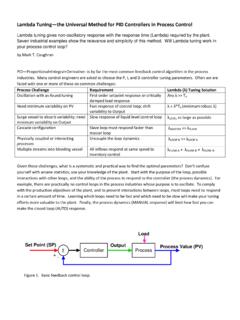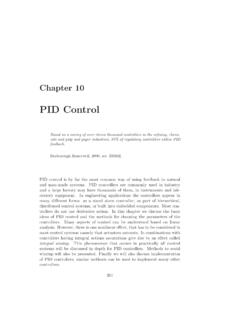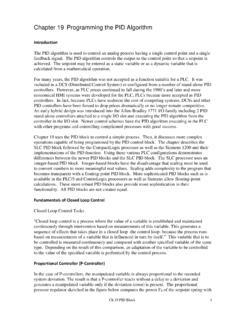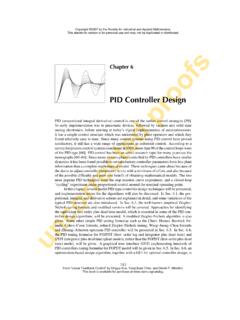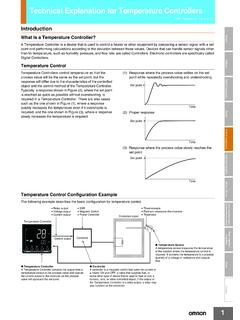Transcription of Chapter 12
1 1 Chapter 12 Fig. Unit-step disturbance responses for the candidate controllers (FOPTD Model: K = 1, 4, 20).== controller Tuning: A Motivational Example2 Chapter 12 PID controller Design, Tuning, and TroubleshootingPerformance Criteria For Closed-Loop Systems The function of a feedback control system is to ensure that the closed loop system has desirable dynamic and steady-state response characteristics. Ideally, we would like the closed-loop system to satisfy the following performance closed-loop system must be effects of disturbances are minimized, providing good disturbance , smooth responses to set-point changes are obtained, that is, good set-point error (offset) is control action is control system is robust, that is, insensitive to changes in process conditions and to inaccuracies in the process controller settings can be determined by a number of alternative Synthesis (DS) Model Control (IMC) tuning response tuningafter the control system is 12 Direct Synthesis Method In the Direct Synthesis (DS)
2 Method, the controller design is based on a process model and a desired closed-loop transfer function. The latter is usually specified for set-point changes, but responses to disturbances can also be utilized (Chen and Seborg, 2002). Although these feedback controllers do not always have a PID structure, the DS method does produce PI or PID controllers for common process models. As a starting point for the analysis, consider the block diagramof a feedback control system in Figure The closed-loop transfer function for set-point changes was derived in Section :(12-1)1mcvpspcvpmKGGGYYGGGG=+5 Chapter 12 Fig. Block diagram for a standard feedback control system.
3 6 Chapter 12 For simplicity, let and assume that Gm= Km. Then Eq. 12-1 reduces tovpmGGGG (12-2)1cspcGGYYGG=+Rearranging and solving for Gcgives an expression for the feedback controller :/1(12-3a)1/spcspYYGGYY = Equation 12-3a cannot be used for controller design because the closed-loop transfer function Y/Yspis not known a priori. Also, it is useful to distinguish between the actual process Gand the model, , that provides an approximation of the process behavior. A practical design equation can be derived by replacing the unknown Gby , and Y/Yspby a desired closed-loop transfer function, (Y/Ysp)d:G G 7 Chapter 12()()/1(12-3b)1/spdcspdYYGGYY = The specification of (Y/Ysp)dis the key design decision and will be considered later in this section.
4 Note that the controller transfer function in (12-3b) contains the inverse of the process model owing to the term. This feature is a distinguishing characteristic of model-based Desired Closed-Loop Transfer FunctionFor processes without time delays, the first-order model in Eq. 12-4 is a reasonable choice,1(12-4)1spcdYYs = + 8 Chapter 12 The model has a settling time of ~ 4 , as shown in Section 5. 2. Because the steady-state gain is one, no offset occurs for set-point changes. By substituting (12-4) into (12-3b) and solving for Gc, the controller design equation becomes: c11(12-5) ccGsG= The term provides integral control action and thus eliminates offset.
5 Design parameter provides a convenient controller tuning parameter that can be used to make the controller more aggressive (small ) or less aggressive (large ).1/ cs c c c9 Chapter 12 If the process transfer function contains a known time delay ,a reasonable choice for the desired closed-loop transfer function is: (12-6) 1sspcdYeYs = + The time-delay term in (12-6) is essential because it is physically impossible for the controlled variable to respond to a set-point change at t= 0, before t= . If the time delay is unknown, must be replaced by an estimate. Combining Eqs. 12-6 and 12-3b gives: 1(12-7) 1scsceGGse =+ 10 Chapter 12 Although this controller is not in a standard PID form, it is physically realizable.
6 Next, we show that the design equation in Eq. 12-7 can be used to derive PID controllers for simple process models. The following derivation is based on approximating the time-delay term in the denominator of (12-7) with a truncated Taylor series expansion: 1 (12-8)ses Substituting (12-8) into the denominator of Eq. 12-7 and rearranging gives() 1(12-9) =+ scsceGGNote that this controller also contains integral control 12 First-Order-plus-Time-Delay (FOPTD) ModelConsider the standard FOPTD model,() (12-10) 1sKeGss =+ Substituting Eq. 12-10 into Eq. 12-9 and rearranging gives a PI controller , with the following controller settings:()11/ ,ccIGKs=+1 , (12-11) cIcKK==+Second-Order-plus-Time-Delay (SOPTD) ModelConsider a SOPTD model,()()() 12(12-12) 1 1sKeGsss =++ 12 Chapter 12 Substitution into Eq.
7 12-9 and rearrangement gives a PID controller in parallel form,11 (12-13) ccDIGKss =++ where:12121212 1, , (12-14) cIDcKK +==+=++Example the DS design method to calculate PID controller settings for the process:()()210151seGss =++13 Chapter 12 Consider three values of the desired closed-loop time constant: . Evaluate the controllers for unit step changes in both the set point and the disturbance, assuming that Gd= G. Repeat the evaluation for two cases:1,3,and10c = process model is perfect ( = G). model gain is = , instead of the actual value, K= 2. Thus,G K ()()10151 Gss=++ The controller settings for this example 1c= 3c=10c =()2cKK= () I D14 Chapter 12 The values of Kcdecrease as increases, but the values of and do not change, as indicated by Eq.
8 12-14. c I DFigure Simulation results for Example (a): correctmodel 12 Fig. Simulation results for Example (b): incorrect model gain. 16 Chapter 12 Internal Model Control (IMC) A more comprehensive model-based design method, Internal Model Control(IMC), was developed by Morariand coworkers (Garcia and Morari, 1982; Rivera et al., 1986). The IMC method, like the DS method, is based on an assumed process model and leads to analytical expressions for the controller settings. These two design methods are closely related and produce identical controllers if the design parameters are specified in a consistent manner. The IMC method is based on the simplified block diagram shown in Fig.
9 A process model and the controller output Pare used to calculate the model response, . G Y 17 Chapter 12 The model response is subtracted from the actual response Y, and the difference, is used as the input signal to theIMC controller , . In general, due to modeling errors and unknown disturbances that are not accounted for in the model. The block diagrams for conventional feedback control and IMC are compared in Fig. *cGYY ()GG ()0D Figure Feedback control strategies18 Chapter 12*cG It can be shown that the two block diagrams are identical if controllers Gcand satisfy the relation**(12-16)1cccGGGG= Thus, any IMC controller is equivalent to a standard feedback controller Gc, and vice versa.
10 The following closed-loop relation for IMC can be derived from Fig. using the block diagram algebra of Chapter 11:*cG()()**1(12-17)11ccspccGGGGYYDGGGGG G =++ + 19 Chapter 12 For the special case of a perfect model, , (12-17) reduces toGG= ()**1(12-18)cspcYGGYGGD=+ The IMC controller is designed in two steps: Step process model is factored as(12-19)GGG+ = where contains any time delays and right-half plane zeros. In addition, is required to have a steady-state gain equal to one in order to ensure that the two factors in Eq. 12-19 are + G+ 20 Chapter 12 Step controller is specified as*1(12-20)cGfG = where fis a low-pass filterwith a steady-state gain of one.



